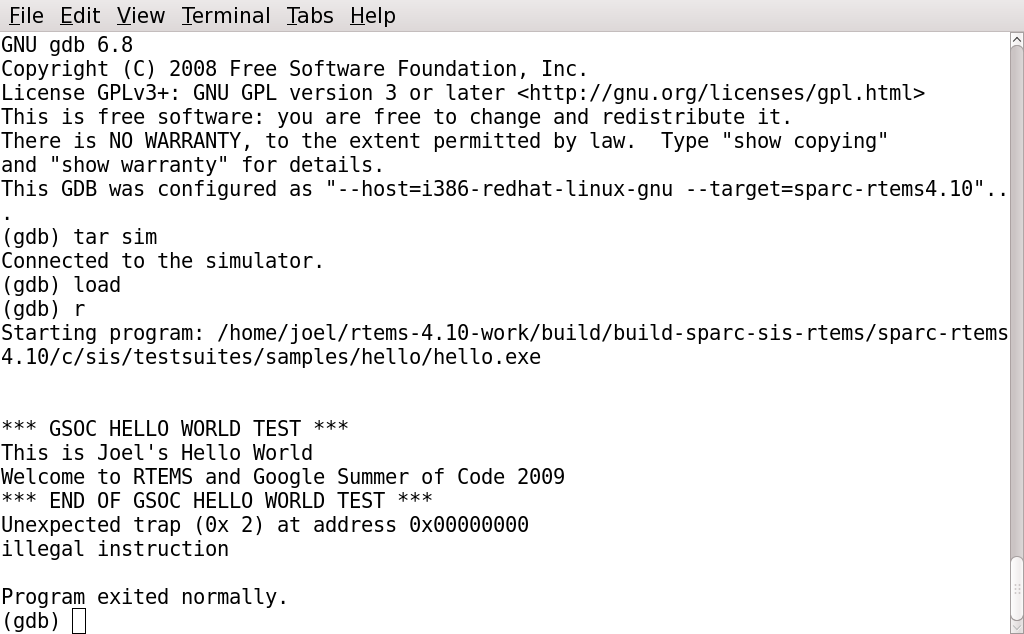| Version 12 (modified by Gedare, on 01/16/12 at 19:38:05) (diff) |
|---|
GSoC Getting Started
Table of Contents
GSoC 2008 was the first time the RTEMS Project participated in the Google Summer of Code. After talking to mentors from other projects, we noticed that we all suffered from a "getting started" issue. You are more likely to have a successful project for any organization in GSoC if you are able to build their code, run their examples and make minor modifications. The quicker you cross this hurdle, the sooner you will be doing "real" work.
Please join the RTEMS Mailing List and speak up. Ask questions. Help correct any deficiency in code or documentation you spot. The ultimate goal of GSoC is not money, it is getting students to participate in the open source community. We don't want this to be a one shot thing.
Configure a Development Computer
You will be best served by using a GNU/Linux distribution for which we provide RPMs. The core RTEMS developers use Fedora and we are best able to support you when we are all on the same development host operating system. As of January 20 2008, most core RTEMS developers have moved to Fedora 10. We will ALWAYS be on a version that is supported by the distribution.
This step involves the following steps.
- Install or update GNU/Linux distribution as needed.
- Install RTEMS Tools. See RTEMS Development Hosts for information but remember we encourage you to use Fedora and thus you will follow the APT/Yum instructions.
As you will be compiling code, it is recommended to have a reasonably fast machine.
Configure and Build RTEMS for SPARC/SIS
- Check out RTEMS from Git. See RTEMS Git Repository? for information.
- Bootstrap RTEMS (covered in Wiki page referenced above).
- Build RTEMS for the SPARC/sis BSP. Quick Start? shows how to do this.
- Run hello world example in source tree.
- Install RTEMS.
The sparc-rtems4.10-gdb session with the unmodified hello world will look something like the following:
Note that this image is careful not to show you how to configure or build the executable being run.
Configure and Build RTEMS for "Preferred" BSP
The preferred BSP depends on your project but your first choice should be a BSP that runs on a simulator included in gdb. SPARC/sis is a good candidate because it is easy to work with. If your project requires a BSP to support TCP/IP of something else not supported by SPARC/sis, then still first try a simple environment like SPARC/sis and then move on to the one that will support your project. Discuss your project requirements on the RTEMS mailing list and let the community help point you in the right direction.
If SPARC/sis is not the right test platform for your project then you will need to ensure you know how to run hello world on your preferred BSP.
Prove You Can Work On RTEMS
<center> SEND DIFF AND SCREEN CAPTURE AS VERIFICATION. </center>
Modify the hello world example to include your name. Something like "Hello Fred!". Then send us enough to prove to us that you did this. We want to know you can work with RTEMS. Ask on the mailing list about how to submit the proof. We want you to be open and active.
Send a "git diff" of your changes. This will look something like this:
diff --git a/testsuites/samples/hello/init.c b/testsuites/samples/hello/init.c
index 8874030..dda8175 100644
--- a/testsuites/samples/hello/init.c
+++ b/testsuites/samples/hello/init.c
@@ -33,9 +33,10 @@ rtems_task Init(
rtems_task_argument ignored
)
{
- printf( "\n\n*** HELLO WORLD TEST ***\n" );
- printf( "Hello World\n" );
- printf( "*** END OF HELLO WORLD TEST ***\n" );
+ printf( "\n\n*** GSOC HELLO WORLD TEST ***\n" );
+ printf( "This is Joel's Hello World\n" );
+ printf( "Welcome to RTEMS and Google Summer of Code 2009\n" );
+ printf( "*** END OF GSOC HELLO WORLD TEST ***\n" );
exit( 0 );
}
- Take a "snapshot" of your modified hello world and send us the png. On GNU/Linux, you should be able to press the "Prnt Scrn" button or use the "xwd" command. This is a snapshot that Joel Sherrill? took after running the hello world program with the above changes.
If your project requires more of a test environment than SPARC/sis provides, then repeat the hello world steps on the BSP we help you select. If your project involves developing a new BSP, then you may want to run on a BSP from the same target architecture on a simulator. Again we will help you select the BSP.
We will assist you in anyway possible along the way. We want you to have a functional RTEMS Development Environment as soon as possible so you can move on to the real project.
Attachments (2)
-
SPARC-SIS-HelloWorld.png (74.6 KB) - added by Amar Takhar on 11/23/14 at 05:06:51.
Imported from old wiki.
-
SPARC-SIS-HelloWorld-Modded.png (76.7 KB) - added by Amar Takhar on 11/23/14 at 05:06:52.
Imported from old wiki.
Download all attachments as: .zip
![[RTEMS Logo]](/images/logo.png)

